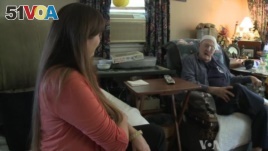November 27,2013
CULPEPER, VIRGINIA — When most people hear the word hospice, they usually associate it with death and dying.
But hospice is more about providing care, comfort and support to terminally ill patients while helping them navigate—and optimize—the final days of their lives.
Preparing for the inevitable
Faye and Wayne Payne lived a rich and interesting life before settling down in a picturesque area of rural Virginia.
But their peaceful existence was shattered when they learned that Faye had lung cancer.

“I did the radiation, and I did the chemo,” she said, “and after I had the last scan done they realized I had more cancer coming up here. And I said ‘No more.’”
After talking it over with her doctors and members of her family, Faye decided to receive hospice care.
Hospice care
A clinical team made up of an aide, a nurse and a social worker from a nearby hospice organization, visit Faye in her home, providing care and comfort while helping prepare her for the inevitable.
“The nurse is looking at the medical things and the social worker at the psycho-social spiritual things,” said social worker Robin Johnson, part of the hospice team that visits Faye regularly. “And that can encompass a lot.”
The clinical team has helped Faye realize that, yes, death is coming, and have helped her prepare for it.
“I now have everything lined up and ready to go,” she said.
Having the extra support helps everyone in the household, says Wayne Payne, Faye’s husband.
“They come along and they take her blood pressure and check her hearing and get her medication and it’s made life a whole lot easier for both of us,” he said.
Extra support
Hospice care is set up to provide care and support for the rest of the family as well, both during and after their patient has passed away.
In most cases, hospice care in the United States is provided in the patient’s own home, or in the home of their loved one, but it may also be provided in freestanding hospice centers, hospitals, nursing homes and other long-term facilities. Patients range in age from newborn through the elderly.
“When people are diagnosed with a terminal illness, and they’re no longer able to have aggressive treatment, they want their treatment to be more focused on comfort and care and symptom management in their home,” said Melissa Mills, assistant director of patient services at Hospice of the Rapidan, which serves terminally ill patients in several counties in the state of Virginia.
Dying with dignity
Being at home, she adds, also allows them autonomy and the choice to die with dignity.
“I think in America we feel like the overall perception is that you have to die in a hospital," she said. "But if you survey people, over 70 percent of the people surveyed don’t want to die in a hospital.
Jim Sykes, 74, is one of those patients who understands and appreciates that choice. Diagnosed two years ago with head and neck cancer, he's been receiving hospice care at home for seven months.
"I'm so glad that I got them," said Sykes, referring to his team of caregivers. "And I would advise anybody, anybody in that situation, to go for it, because they make your life so much better.
Many of social worker Lisa Stone's visits with Sykes include supportive listening. They also spend time looking at photographs.
“Jim has his black book of photos so we do what I like to call photo therapy," she said.

Eric Lindner, a hospice volunteer since 2009, has written about his experiences in a book called "Hospice Voices."
"Now I’m not afraid," he said. "I’m not a bit afraid to go now.”
Eric Lindner, a hospice volunteer since 2009, has written about his experiences in a book called Hospice Voices and believes hospice provides a support system that’s largely missing in American culture.
“I’ve travelled a fair bit—China, Africa, other places—and the elders are embraced and taken into the family,” he said. “In this country, just the way it’s developed, maybe that’s the role that hospice has tried to fill a little bit.”
That support has helped patients like Faye Payne focus on the quality of life they’re enjoying today. She recently became a great-grandmother and has been savoring her time with the new baby.
But when the time comes for her to leave this earth, she is ready.
“I was born July 16, in 1942, but my dad was working on the railroad and he died April 16, 1942, so I want to get to see my dad one day, that’s the main thing," Faye said. "I have no regrets and I’m not afraid.”